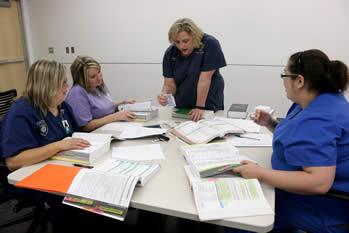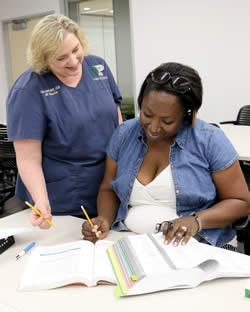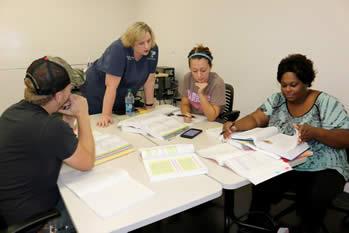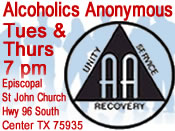 October 7, 2015 - Check your health insurance statements and explanation of benefits carefully for the next few months, advises Jo Ellen Russell, Program Director and Professor of Health Information Technology at Panola College.
October 7, 2015 - Check your health insurance statements and explanation of benefits carefully for the next few months, advises Jo Ellen Russell, Program Director and Professor of Health Information Technology at Panola College.
On October 1, hospitals and doctors made the transition to a new and far more complex coding system to describe health insurance claims and other electronic health transactions. The new government-mandated “ICD-10-CM” codes number more than 69,000 different descriptions, up from 14,000 used by the previous system, which had been in use since 1979.
ICD-10 stands for International Classification of Diseases, Tenth Revision. The new system was delayed for two years, but went into effect this month as required by the Centers for Medicare & Medicaid Services (CMS).
Russell said the new system is designed to help improve recordkeeping, and provide better tools for measuring and evaluating patients and their conditions. The transition to the new system could create problems, however, as the healthcare community adapts to the multitude of different numbers assigned to conditions and diseases.
“We have been preparing for this for the past couple of years,” Russell says. “Panola College Health Information Technology students are already learning the new codes so they will be ready to go to work in healthcare settings once they complete their associate degree or certificate.”
 Professor Lynn Davis is an officially trained ICD-10 Ambassador, certified through the American Health Information Management Association (AHIMA), a designation that means she is knowledgeable and can legally train others in the new coding process.
Professor Lynn Davis is an officially trained ICD-10 Ambassador, certified through the American Health Information Management Association (AHIMA), a designation that means she is knowledgeable and can legally train others in the new coding process.
In late October or early November, Davis will offer an ICD-10 Continuing Education Course in which students may earn the 10 CE hours required for all coding certified professionals. Interested students may contact the Panola College Workforce and Continuing Education Department at 903-693-2067 or visit online at http://www.panola.edu/wkfc-cont-ed/.
Delays in processing of claims, along with potential coding errors are two areas of concern in the coming weeks with the new system, according to Russell. She encourages people to carefully review any correspondence from their healthcare providers during the transition period.
The Health Information Technology program at Panola College offers an Associate of Applied Science in Health Information Technology, a two-year program that combines clinical knowledge and information management skills. Students may choose to earn a Medical Coding Technician certificate, which is a shorter program that trains students to review and analyze health records to identify relevant diagnoses and procedures for reimbursement, to assess clinical care and to support research.
Students who complete the HIT program at Panola College may pursue careers in healthcare facilities, consulting firms, government agencies, insurance companies, pharmaceutical companies and other healthcare vendors and providers.
“Health Information Management programs incorporate the disciplines of medicine, management, finance, information technology and law into one curriculum,” Russell explains. “Because of this unique mixture, graduates can choose from a variety of work settings across an array of healthcare environments.”
Panola’s program, which includes both online and face-to-face classes, is fully accredited by the Commission on Accreditation for Health Informatics and Information Management Education. Students who complete the associate degree at Panola may choose to transfer to a university to pursue a bachelor’s degree in Health Information Management.
 In September, Forbes Magazine ranked Health Technology as the most profitable industry for 2015, with a 21 percent net profit margin, according to Factset, a financial research tool. People who work in HIT can earn from $35 to $70 thousand annually, depending on their earned credentials and work location. A salary survey conducted by the AHIMA revealed that the overall 2012-year ending average salary across all AHIMA survey respondents came in at approximately $65,963, more than a 10 percent increase from the 2010 average.
In September, Forbes Magazine ranked Health Technology as the most profitable industry for 2015, with a 21 percent net profit margin, according to Factset, a financial research tool. People who work in HIT can earn from $35 to $70 thousand annually, depending on their earned credentials and work location. A salary survey conducted by the AHIMA revealed that the overall 2012-year ending average salary across all AHIMA survey respondents came in at approximately $65,963, more than a 10 percent increase from the 2010 average.
HIT graduates are eligible to earn additional certificates including Registered Health Information Technician (RHIT) and Certified Coding Associate (CCA) from the American Health Information Association, as well as Certified Professional Coder (CPC) from the American Academy of Professional Coders.
The Bureau of Labor Statistics said that for 2012 the median pay for medical records and health information technicians was $34,160 per year, or $16.42 per hour. The job outlook for 2012-2022 predicts 22 percent growth in the industry, a rate much faster than average.
“Health Information Technology is such a rewarding career for someone who is motivated and eager for the challenge that it brings,” Davis says.
Russell’s department includes instructors Davis and Kimberly Bishop, along with department secretary Kelley Hammond. To find out more about HITT at Panola College, go to the webpage at http://www.panola.edu/programs/health-sciences/hit/index.html or call Davis at 903-693-1116.








